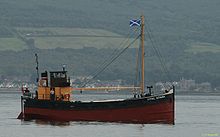Clyde buffer
The Clyde Puffer is an inland and coastal ship type on the Scottish west coast. It was built from around 1850 until the early 1950s.
description
The Clyde Puffer is a small inland and coastal cargo ship type, which was initially used on Scottish canals, later also in the estuaries of the Forth and Clyde and finally on the entire Scottish west coast to the Hebrides. The crew of the smaller buffers consisted of the master and three, that of the larger of four sailors. The crew lived in a logis under the forecastle, the captain had a small living room in the aft. A single mast with a boom for cargo handling stood in front of the single large hold . The chimney was located aft behind the hatch, followed by the steering position. The closed wheelhouse was only introduced in the first decade from 1900. Early Clyde buffers were powered by simple steam engines without a condenser, whose typical sound of the rhythmic release of steam gave the ship its name. Although later Clyde buffers received capacitors and later even diesel engines, both of which did not make the typical steam noise, the name was retained.
history
The ship type of the Clyde Buffer appeared as a pure inland cargo ship from around 1850. The dimensions of these vehicles were therefore limited by the lock sizes of the Forth-Clyde Canal to a length of 20.30 meters and a width of 5.54 meters.
In the course of development, the design of the ships was extended to the so-called Shorehead type, so that it could be used up to the mouths of the Forth and Clyde. From around 1900 a further developed Outside type came into use, which was also suitable for trips across the sea and was used in coastal voyages as far as the Hebrides . A larger freeboard made these ships seaworthy. Most of these ships initially stayed with the canal dimensions, but some were up to 26.60 meters in length.
Around the time between the two world wars, the number of ships used continued to decrease, as the land transport routes were continuously expanded, while the coal required to operate the ships became more and more expensive, as did maintenance and personnel costs. Nonetheless, more real buffers were built into the 1930s.
During the Second World War, new tasks arose for this type of ship, such as supplying the fleet, which prompted the government to order the construction of the so-called Victualling Inshore Craft (VIC). The VIC design was based on the lines of the ships Anxac and Lascar, built in 1939 . In the years 1941 to 1946, over a hundred VIC-Clyde buffers were created. Up to VIC 49 all ships were 20.50 meters long, after that 29.60 meters long VICs were also built.
today
A number of Clyde buffers have survived to this day. The oldest buffer still in existence is probably the Basuto , built in 1902 by the National Waterways Museum in Ellesmere Port. Other ships have also been preserved from other museums. Some of the other ships are still in service and are now partially used for tourist trips.
Web links
- Description of the Clyde buffer ( English )


